Affiliate marketing has become one of the most reliable income streams for tech bloggers. From recommending hosting platforms to reviewing the latest gadgets, affiliate partnerships allow bloggers to earn while genuinely helping their readers. But here’s the catch: affiliate marketing is not just about dropping links and waiting for commissions to roll in. It’s a craft, and like any craft, mistakes can cost you both money and credibility.
The truth is, affiliate marketing for tech bloggers is more competitive than ever. Readers are smarter, algorithms are stricter, and the products you recommend often involve bigger investments from buyers (think software subscriptions, smartphones, and productivity tools). If you’re careless, you’ll lose your readers’ trust in seconds. But if you avoid the common pitfalls, affiliate marketing can grow into a sustainable, long-term revenue stream.
In this post, we’ll walk through the 10 biggest affiliate marketing mistakes tech bloggers make, why they matter, and most importantly—how you can avoid them. By the end, you’ll not only know what not to do but also how to turn your blog into a trustworthy, reader-first platform that generates consistent affiliate income.
1. Promoting Products You Don’t Believe In
This is the cardinal sin of affiliate marketing: recommending something you don’t use, don’t trust, or have no experience with. It’s tempting—especially when you see programs offering high commissions—but it always backfires.
Why it hurts you:
- Your audience can sense when you’re being insincere.
- If readers buy and have a poor experience, they’ll blame you—not the company.
- Your credibility, once lost, is nearly impossible to rebuild.
Better approach:
- Stick to products you’ve tested personally. For example, if you’re reviewing a new coding laptop, share your actual benchmarks, photos, or user experience.
- If you can’t try the product yourself, research deeply, cite trusted sources, and make it clear to readers you haven’t tested it hands-on.
- Balance honesty with recommendation. Instead of “This is the best ever,” try “This might be a great fit if you’re a beginner coder, but advanced developers may prefer X.”
Trust is your most valuable currency as a blogger. Protect it fiercely.
2. Forgetting Who Your Audience Is
Affiliate marketing only works when your promotions match your readers’ needs. A common mistake tech bloggers make is chasing affiliate programs with high payouts—even if their audience has no interest in those products.
For example: if your blog attracts college students looking for budget-friendly tools, pushing enterprise-level project management software at $100/month is pointless.
Why it hurts you:
- Recommendations feel irrelevant.
- Readers stop clicking your links.
- Conversions plummet because the offer doesn’t solve your audience’s problem.
Better approach:
- Create reader personas. Are they students, freelance developers, startup founders, or corporate IT managers?
- Match affiliate promotions to their actual needs. For students, that might mean affordable hosting or free code editors. For professionals, premium cloud tools might make more sense.
- Use surveys, polls, or blog comments to better understand what your audience is struggling with.
When you serve your readers first, affiliate revenue grows naturally.
3. Stuffing Posts with Affiliate Links
Yes, you want clicks. But sprinkling 30 affiliate links across a 1,000-word blog post is the fastest way to look spammy.
Why it hurts you:
- Readers feel pressured instead of informed.
- Google may penalize you for excessive outbound affiliate links.
- It ruins readability and makes your blog feel like a sales pitch instead of a resource.
Better approach:
- Use affiliate links strategically—one or two per section is usually enough.
- Place links where they make the most sense: after explaining a benefit, in comparison tables, or as part of a call-to-action.
- Mix affiliate links with non-affiliate resources so it doesn’t feel forced.
Less is often more. One well-placed link in a trusted review can convert better than 20 scattered links across the page.
4. Skipping Affiliate Disclosures
Some bloggers avoid disclosures because they fear it will scare readers off. In reality, hiding your affiliate relationships does more harm than good—and it’s against the law in many places.
Why it hurts you:
- Violates FTC (in the U.S.) and similar global guidelines.
- Readers may feel tricked if they discover your affiliate relationship later.
- You risk getting kicked out of affiliate programs.
Better approach:
- Add a simple, transparent note: “This post contains affiliate links. If you purchase through them, I may earn a commission at no extra cost to you.”
- Place disclosures at the top of your post and near links where relevant.
- See disclosure as part of building trust, not as a burden.
Readers value honesty. If they trust you, they won’t mind you earning a commission.
5. Writing Only to Sell
Affiliate marketing doesn’t mean every post needs to be a pitch. If your blog feels like a nonstop commercial, readers will leave.
Why it hurts you:
- Readers don’t come for sales—they come for value.
- You lose authority if your blog reads like an ad catalog.
- Engagement (shares, comments, backlinks) drops dramatically.
Better approach:
- Focus on creating genuinely useful content—tutorials, how-to guides, comparisons, troubleshooting tips.
- Weave affiliate links naturally into your helpful content. For example, in a “How to Speed Up WordPress” guide, recommending a reliable caching plugin makes sense.
- Follow the 80/20 rule: 80% value, 20% monetization.
When you help first and sell second, conversions actually increase.
6. Ignoring Analytics and Optimization
Dropping links without tracking performance is like sailing without a compass. You might get lucky, but you’ll never truly know what’s working.
Why it hurts you:
- You waste time on low-converting strategies.
- You can’t identify your best-performing content.
- Growth stalls because you’re flying blind.
Better approach:
- Track clicks and conversions using your affiliate dashboard or tools like Pretty Links, ThirstyAffiliates, or Google Analytics.
- Test different link placements (in-text vs. button vs. comparison tables).
- Analyze which blog posts drive the most revenue and create more like them.
Affiliate marketing is about data as much as content. The numbers tell you where to double down.
7. Joining Every Affiliate Program You See
It’s easy to fall into the trap of joining dozens of affiliate programs just because they’re available. But spreading yourself too thin often leads to promoting low-quality products—or none consistently at all.
Why it hurts you:
- Too many irrelevant links overwhelm your audience.
- Some programs may be unreliable (delayed payouts, broken tracking).
- You dilute your authority by promoting everything under the sun.
Better approach:
- Choose affiliate programs carefully. Look for high-quality products, decent commission rates, and reliable payment systems.
- Stick with fewer, stronger partnerships.
- Prioritize programs that align closely with your niche. A web developer blog recommending hosting providers makes sense; a random fitness supplement does not.
A few strong, trusted programs can outperform dozens of weak ones.
8. Forgetting SEO Basics
Your affiliate content won’t matter if nobody finds it. Many tech bloggers ignore SEO, thinking social media alone will drive traffic. But SEO is where the long-term growth happens.
Why it hurts you:
- Missed organic traffic = fewer affiliate clicks.
- Dependence on unpredictable traffic sources (like social media).
- Lost visibility to competitors who do optimize.
Better approach:
- Research buyer-intent keywords (e.g., “best laptop for programming 2025”).
- Optimize on-page elements like headings, meta descriptions, and images.
- Build backlinks by guest posting or collaborating with other bloggers.
Good SEO means your affiliate content keeps working for you months—or even years—after publishing.
9. Overlooking Mobile Readers
With more than half of web traffic coming from mobile, a desktop-only blog is leaving money on the table. If your links, buttons, or pages don’t work smoothly on mobile, you’re losing conversions daily.
Why it hurts you:
- Readers abandon slow or unresponsive sites.
- Google ranks mobile-friendly pages higher.
- Mobile shoppers can’t complete purchases easily.
Better approach:
- Use a responsive WordPress theme.
- Test your site across multiple devices.
- Improve load speed with caching, image compression, and lightweight plugins.
Convenience is king. If mobile users can’t buy easily, they won’t.
10. Giving Up Too Early
Affiliate marketing takes time. Many bloggers quit after three or six months when they don’t see results, not realizing that success often snowballs after consistent effort.
Why it hurts you:
- You miss out on the compounding effect of SEO and loyal readership.
- You don’t gather enough data to optimize properly.
- Competitors who stick it out overtake you.
Better approach:
- Set realistic expectations: affiliate income is often slow in the first year.
- Keep publishing, optimizing, and engaging with readers.
- Treat your blog as a business, not a side hustle experiment.
Patience separates those who succeed from those who quit too soon.
Final Thoughts
Affiliate marketing can be incredibly rewarding for tech bloggers, but only when approached with strategy, patience, and integrity. The mistakes we covered—from promoting irrelevant products to neglecting SEO—are common, but they’re also entirely avoidable.
Here’s the golden rule: Put your audience first. When your readers know you care about their success, they’ll trust your recommendations. And with trust, affiliate income follows.
Take time to:
- Build relationships with your audience.
- Promote only the tools and products you truly believe in.
- Optimize your content, measure results, and keep improving.
Avoid these 10 pitfalls, and you’ll be well on your way to building not just a profitable affiliate strategy—but a respected, sustainable blogging business.






